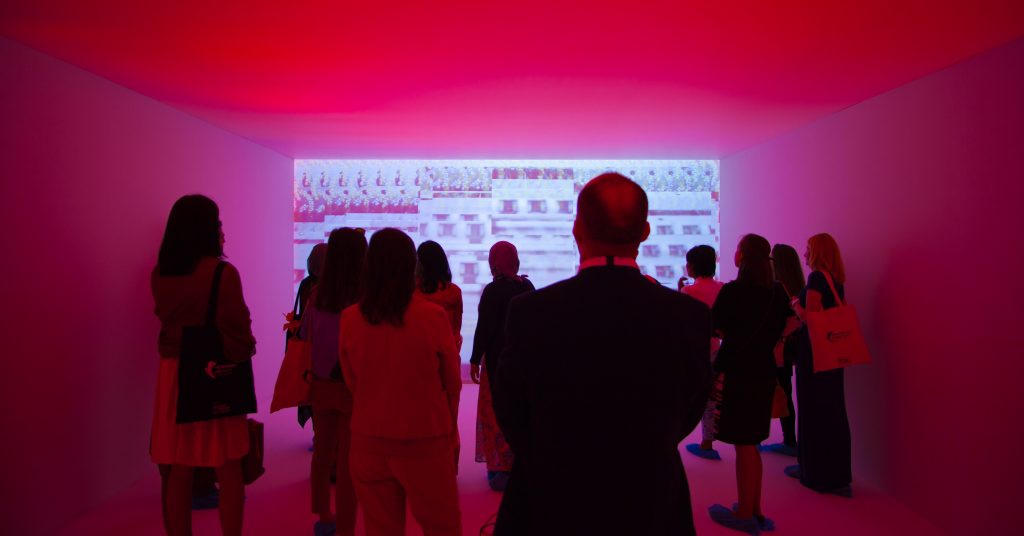Blog
Stop Shouting Future, Start Doing It
Whilst researching Better Care Systems for a project we are currently working on with Doteveryone, I came across the work of economist and feminist Nancy Folbre. Nancy has worked extensively in the space of “caring labour” and her work articulates this immeasurable labour, often done by women, and how difficult it is to imagine alternative economic visions for such forms of labour. In one of her essays, Nancy acknowledges that whilst ‘economists are kind of engineers of the utopian, our job is to take care of the nuts and bolts of that alternative economic system; I think we depend on artists and writers to help us see where we want to go.” Something akin to this sentiment from Nancy was a leitmotif throughout much of Milica Begovic, Joost Beunderman, Indy Johar’s thinking on the need for more experimentation if we are to reimagine governance adequate for 21st century.
I encounter this desire for ‘imaginative’, ‘creative’, ‘artistic’ future visions from various different places — from CEOs, scientists, economists, technologists, governments, policy makers and so on. Many are searching for those beacons-of-hope, beacons to guide us towards “better futures”. There is a hunger for alternative visions, ideas, experiments. Radical imaginings that grasp the interconnected nature of complex systems; help navigate uncertainty; and shake up present day dogmatism. We welcome this desire with open arms.

Photograph from our situated simulation ‘Stark Choices’ where we transported people, viscerally and experientially, into two possible futures of work.
But the question is, whether desire is enough? Is there enough courage and commitment from those with decision-making power to actually follow through on that desire? While the appetite for innovative ideas abounds, there is less gumption when it comes to following alternative trajectories. This is where it gets tricky. So many visionary initiatives launched with the desire to be “radical”, “experimental” and “imaginative” end up incubating programs that seek to accelerate growth. Now, I have no problem with the intention behind such programs, but I have observed that as they are mapped and built, their metrics of success move further and further away from the intent with which they were created. Some initiatives end up as unrealised strategy documents, that then get evaluated on quarterly or annual ROI metrics. Others die when the individuals who drive experimentation and critical thinking leave the organisation. In worst case scenarios this happens.
Where there is the capacity (cognitive, intellectual and emotional) to forfeit fear for uncertainty, to let go the clutches of deeply ingrained structures, and give way to the unknown, the results have been astonishing. In his book ‘Being Mortal’ Atul Gwande writes about this incredible young doctor, Bill Thomas, who was put in charge of a care home. Bill was so taken aback by the despair he sensed there, that acting on little more than instinct, he decided to literally put some life into the nursing home. He spent hours, days, and weeks convincing management, regulatory and medical authorities. He even sourced an “innovation grant” to carry out his plan. This plan was to welcome two dogs, four cats, one hundred parakeets and an abundance of bona fide living plants (rather than miserable fake ones) into the care home — all in one day.
And so, that’s what happened, and yes, there was total pandemonium. But then, over the course of three months, the results were astonishing. Medical costs plummeted. Patients reported feeling much healthier. In many cases, looking after the animals, birds and plants literally saved lives, and most importantly, it gave the residents a raison d’être. What Dr. Thomas managed to pursue despite all odds, was an alternative, radical vision. He followed through on something that felt totally impossible. What this proves is that it takes instinct, guts, imagination, and commitment to challenge the status quo and then, critically, follow that through with integrity. But the outcome can be spectacular.
I would like to emphasise that we don’t need 100 parakeets to be let loose inside corridors of powers in order to commit to alternate, as-yet-unwritten futures (although the image of hundreds of birds flying loose inside Westminster is difficult to shake off). Smaller scale projects and experiments, when nurtured over time, can effectively “take you there”; to directly experience alternative perspectives without being unencumbered by the inertia of habit, custom, law, or prejudice.

Photographs from our immersive installation ‘Mitigation of Shock’ where we endeavours to design responses to near future first world disasters, by prototyping alternatives today.
How do we unwaveringly commit to this kind of flexible, pluralistic mentality, though? How do we approach such work long term, without falling into THE TRAP? Here I’ll borrow from Nora Bateson to define one key trap: “Short-term reward, long-term damage: greed over curiosity.” Designing alternative lexicons and resisting the urge to seamlessly embed such work inside “strategy” and “roadmaps” is key to such work. Because imaginative experiments don’t — and shouldn’t — immediately align with existing structures (be they policies, products, services, financial models). Their very intention is to demonstrate alternates.
Realistically, it is best to think of this as PHASE CHANGE. A shiny new future won’t immediately materialise merely because alternatives are being considered. Our work with organisations is about garnering a long term commitment to the constant consideration, imagining and testing of plural possibilities. Awareness of challenges isn’t enough. Responsive action, and an openness to constant change is essential, too.
In the next post, we will write more on what can help us practice such phase change and plurality.
…
Huge thanks to my colleagues; Danielle Knight for her insights and ninja editing, and Jon Ardern for continually pushing our thinking at the Studio.